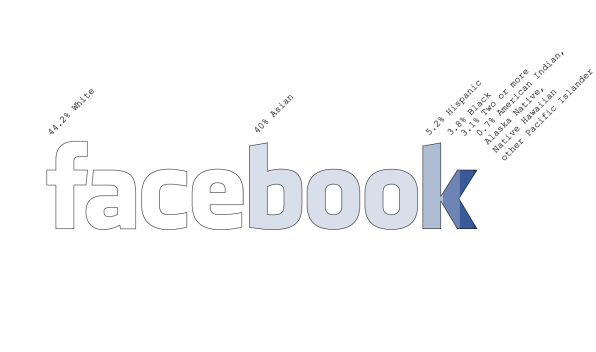
Section Five - Diversity in teams
A story on men on Pinterest and women soccer players in FIFA from EA Sports (5 minutes)
Geek Girls in Paradise
Remember the video we showed you in crash course one? If you forgot it, or if you do the crash courses in a different order, here it is again.
This video has a simple message: programmers are making software that is solving their problems! They are trying to change the world into a world they want to live in! And, these programmers, designers and inventors are mainly white. And male. And nerds. So, they are creating a world that is designed for men like that!
A paradise for nerds.
That is why we need more diverse teams to design technology.
Diversity in Big Tech
Diversity in Big Tech is still a big problem if you look at the numbers. In section six we included a link to a page on Fast Company where they made great visualizations using the logos of the Big Tech companies.
 (picture from Fast Company)
(picture from Fast Company)
In the picture above (from 2018) you see Facebook was still primarily a male organization. This should come as no surprise. Facebook originated from an application that allowed you to compare women. The principles of the platform were invented by men. In recent years Big Tech companies have worked hard on hiring more women but it is still more difficult to find female techies.
 (picture from Fast Company)
(picture from Fast Company)
In addition, Big Tech companies are also predominantly white and/or Asian. In the picture above you see that represented by Facebook in 2018.
If your development teams are not diverse and your organization mainly employs one type of person, you run the great risk of developing products that match the worldview of your staff. This often leads to major problems for people who do not fit into that worldview. We have seen the results (gender bias, racial bias, and so on) in this crash course.
So more diverse teams seems like a good idea!
Diversity makes you money!
In recent years, we have seen that technology companies are becoming increasingly diverse. This is because of the arguments above, but there is another, more practical reason. More varied teams make products that appeal to more people and thus more product can be sold and more money can be made.
Diversity can drive innovation, make the world a better place and make you more money.
What's not to like?
This video explains, with some great examples, like Pinterest for Men, female soccer players in EA Sports and so on.
Too much Diversity & Inclusivity?
In this crash course we talked about diversity and inclusivity and we have stood up for more diversity and inclusion. However, as with almost everything in life, too much is not good either. Recent research shows that too much diversity and inclusion is by no means always good for an organization. Four risks can arise:
- Little inclusion and diversity. Leveling out: too little individuality of people in the organization;
- A lot of diversity, little inclusivity. Fragmentation: Too many categories of employees in the organization
- Little diversity, a lot of inclusivity. Absorption: too much internal tolerance; culture is too open; one is too nice to each other
- A lot of inclusivity and a lot of diversity. Isolation: D&I policy is too far removed from reality; hazard blindness
In short, there is a sweet spot that is slightly different for every organization and finding that sweet spot is a balancing act!
Take aways from section five:
- Diversity is still a problem in Big Tech;
- However,things are changing;
- A practical reason is that diverse teams can make you money;
- But like most things finding the sweet spot in your D&I policy is a balncing act.
Some final words on crash course six
Congratulations! You have completed this crash course, so you got a very small taste of thinking about technology and inclusivity. This was just an appetizer. If you are going to think about, assess, design, program, discuss, use or invent a technology we would like you to remember that:
- Inclusivity in technology is not self-evident;
- Technology is often racially biased;
- Technology is often gender biased;
- This goes beyond algorithms and apps. It's about technology in general;
- In the future, when technology becomes even more dominant, creating inclusive technology will only become more important;
- It helps to be aware of the potential bias, as technology is often made with the best of intentions;
- Working with a divers team is an important step in the right direction.
And remember: inclusive technology means that your technology is for everyone, which means more money for you!
Want more?
This was a crash course. It only took you one hour to complete. If you want more, we have some suggestions:
- First, you can check out section six, with all kinds of additional materials. Section six is updated regularly;
- Second, you can do one of the other ten crash courses;
- Third, you can start using the Technology Impact Cycle Tool, especially the questions regarding inclusivity;
- Fourth, you can check out our example cases, for example inclusivity and the Corona Contact Tracing App.
Finally, do you have any suggestions or remarks on this course? Let us know at info@tict.io
